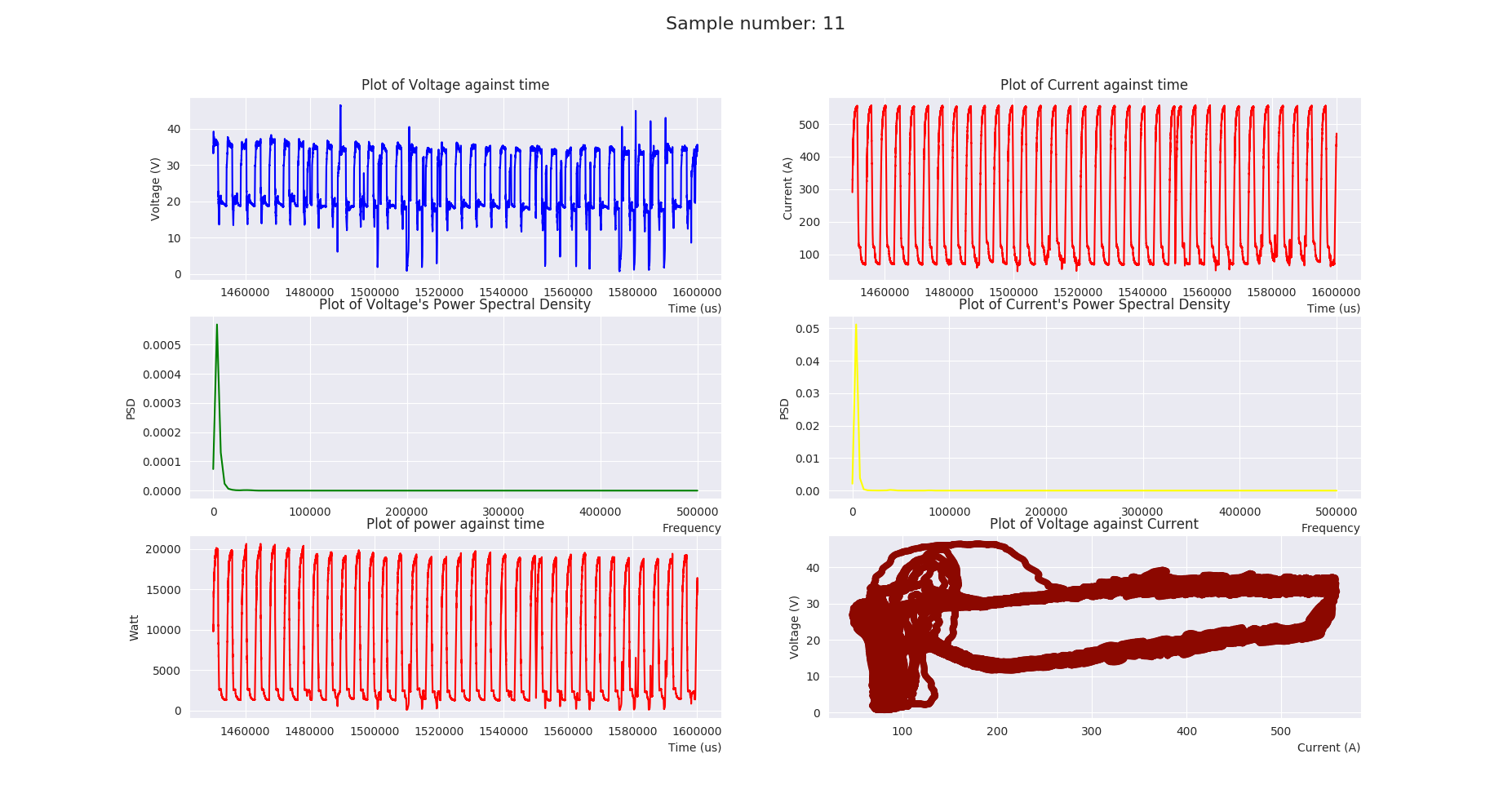Reputation:
Can't seem to get welch function in scipy work correctly
I'm trying to learn DSP through using Python's scipy package.
I have measure some 200Hz signal from a machine. Now I want to inspect the spectral density of the signal. Here's the signal plotted out:

As you can see, the signal is obviously not a low frequency signal. However, I still get the PSD graph like below. Here's the code I have been using:
def plot_and_save(sample,i=""):
filepath = sample + "/" + "merged_data.csv"
df = pd.read_csv(filepath)
sns.set_style("darkgrid")
sns.set_colodef plot_and_save(sample,i=""):r_codes("dark")
fig1, axes = plt.subplots(3,2)
fig1.figsize = [1920,1080]
axes[0,0].plot(df["Time"], df["Voltage"], marker="",color="blue")
axes[0,0].set_title("Plot of Voltage against time")
axes[0,0].set_xlabel("Time (us)", ha= "right", x=1.0)
axes[0,0].set_ylabel("Voltage (V)")
axes[0,1].plot(df["Time"], df["Current"], marker="",color="red")
axes[0,1].set_title("Plot of Current against time")
axes[0,1].set_xlabel("Time (us)", ha= "right",x=1.0)
axes[0,1].set_ylabel("Current (A)")
sampling_freq = 1e6
vol_f, vol_psd = welch(df["Voltage"].to_numpy(), fs=sampling_freq)
axes[1,0].plot(vol_f, vol_psd, marker="",color="green")
axes[1,0].set_title("Plot of Voltage's Power Spectral Density")
axes[1,0].set_xlabel("Frequency", ha= "right",x=1.0)
axfilepath = sample + "/" + "merged_data.csv"
df = pd.read_csv(filepath)
sns.set_style("darkgrid")
sns.set_color_codes("dark")
fig1, axes = plt.subplots(3,2)
fig1.figsize = [1920,1080]
axes[0,0].plot(df["Time"], df["Voltage"], marker="",color="blue")
axes[0,0].set_title("Plot of Voltage against time")
axes[0,0].set_xlabel("Time (us)", ha= "right", x=1.0)
axes[0,0].set_ylabel("Voltage (V)")
axes[0,1].plot(df["Time"], df["Current"], marker="",color="red")
axes[0,1].set_title("Plot of Current against time")
axes[0,1].set_xlabel("Time (us)", ha= "right",x=1.0)
axes[0,1].set_ylabel("Current (A)")
sampling_freq = 1e6
vol_f, vol_psd = welch(df["Voltage"].to_numpy(), fs=sampling_freq)
axes[1,0].plot(vol_f, vol_psd, marker="",color="green")
axes[1,0].set_title("Plot of Voltage's Power Spectral Density")
axes[1,0].set_xlabel("Frequency", ha= "right",x=1.0)
axes[1,0].set_ylabel("PSD")
cur_f, cur_psd = welch(df["Current"], fs=sampling_freq)
axes[1,1].plot(cur_f, cur_psd, marker="",color="yellow")
axes[1,1].set_title("Plot of Current's Power Spectral Density")
axes[1,1].set_xlabel("Frequency", ha= "right",x=1.0)
axes[1,1].set_ylabel("PSD")
axes[2,0].plot(df["Time"], df["Current"]*df["Voltage"], marker="",color="red")def plot_and_save(sample,i=""):
axes[2,0].set_title("Plot of power against time")
axes[2,0].set_xlabel("Time (us)", ha= "right",x=1.0)
axes[2,0].set_ylabel("Watt")
sns.scatterplot(x="Current", y="Voltage", data=df, ax=axes[2,1], color = 'r', edgecolor="None", linewidth=0)
axes[2,1].set_title("Plot of Voltage against Current")
axes[2,1].set_xlabel("Current (A)", ha="right", x=1.0)
axes[2,1].set_ylabel("Voltage (V)")
fig1.suptitle("Sample number: " + str(i+5),fontsize=16)
# plt.savefig("formatted/"+date+"/figure/"+str(i+5)def plot_and_save(sample,i=""):".svg",format="svg")
plt.show()es[1,0].set_ylabel("PSD")
cur_f, cur_psd = welch(df["Current"], fs=sampling_freq)
axes[1,1].plot(cur_f, cur_psd, marker="",color="yellow")
axes[1,1].set_title("Plot of Current's Power Spectral Density")
axes[1,1].set_xlabel("Frequency", ha= "right",x=1.0)
axes[1,1].set_ylabel("PSD")
axes[2,0].plot(df["Time"], df["Current"]*df["Voltage"], marker="",color="red")
axes[2,0].set_title("Plot of power against time")
axes[2,0].set_xlabel("Time (us)", ha= "right",x=1.0)
axes[2,0].set_ylabel("Watt")
sns.scatterplot(x="Current", y="Voltage", data=df, ax=axes[2,1], color = 'r', edgecolor="None", linewidth=0)
axes[2,1].set_title("Plot of Voltage against Current")
axes[2,1].set_xlabel("Current (A)", ha="right", x=1.0)
axes[2,1].set_ylabel("Voltage (V)")
fig1.suptitle("Sample number: " + str(i+5),fontsize=16)
# plt.savefig("formatted/"+date+"/figure/"+str(i+5)".svg",format="svg")
plt.show()
Thank you so much for the help!
Upvotes: 1
Views: 1432
Answers (1)

Reputation: 447
Here's a minimum working example for computing a PSD. I think your problem might be that you leave nperseg option to default, which is 256 points, according to the documentation. What you want to do is include enough samples in each segments to make sure that the dominant features of the signal are included. My rough guidance would be at least 1.5-2.0 times the period.
import numpy as np
import matplotlib.pyplot as plt
from scipy.signal import welch
# Generate signal
freq = 1.0 # Hz
t = np.linspace(0, 10, 1000)
y = np.sin(2.*np.pi*freq*t) + 0.2*np.random.random(len(t))
# Compute no. samples per segment
nSegments = 3
overlap = 0.5
nPerSeg = np.round(len(y)//nSegments / overlap)
if nSegments == 1:
nPerSeg = len(y)
nOverlap = np.round(overlap * nPerSeg)
# Compute sampling rate.
dt = t[1] - t[0]
# Compute PSD
f, psd = welch(y, fs=1./dt,
window="hamm", nperseg=nPerSeg, noverlap=nOverlap, nfft=None, detrend="constant",
return_onesided=True, scaling="density")
# Plot
plt.figure()
plt.plot(t, y)
plt.figure()
plt.plot(f/freq, psd)
plt.xscale("log")
plt.yscale("log")
plt.grid()
plt.xlabel("f/freq")
plt.ylabel("PSD of y")
plt.show()
Expected result shows peak at the main signal frequency:
Upvotes: 1
Related Questions
- Usage of signal.welch
- Which parameters of welch do determin the length of the output? (python)
- python signal.scipy.welch for complex input returns frequency indices which are not ordered negative to positive
- Welch's ANOVA in Python
- Scipy welch and MATLAB pwelch does not provide same answer
- equivalence scipy.signal welch to matlab pwelch
- Why does scipy.signal.welch suppress zero frequency?
- Different result using welch function between Matlab and Python
- Using Scipy's signal.welch command on data: ValueError and a dimension mismatch?
- Can't find the right energy using scipy.signal.welch
